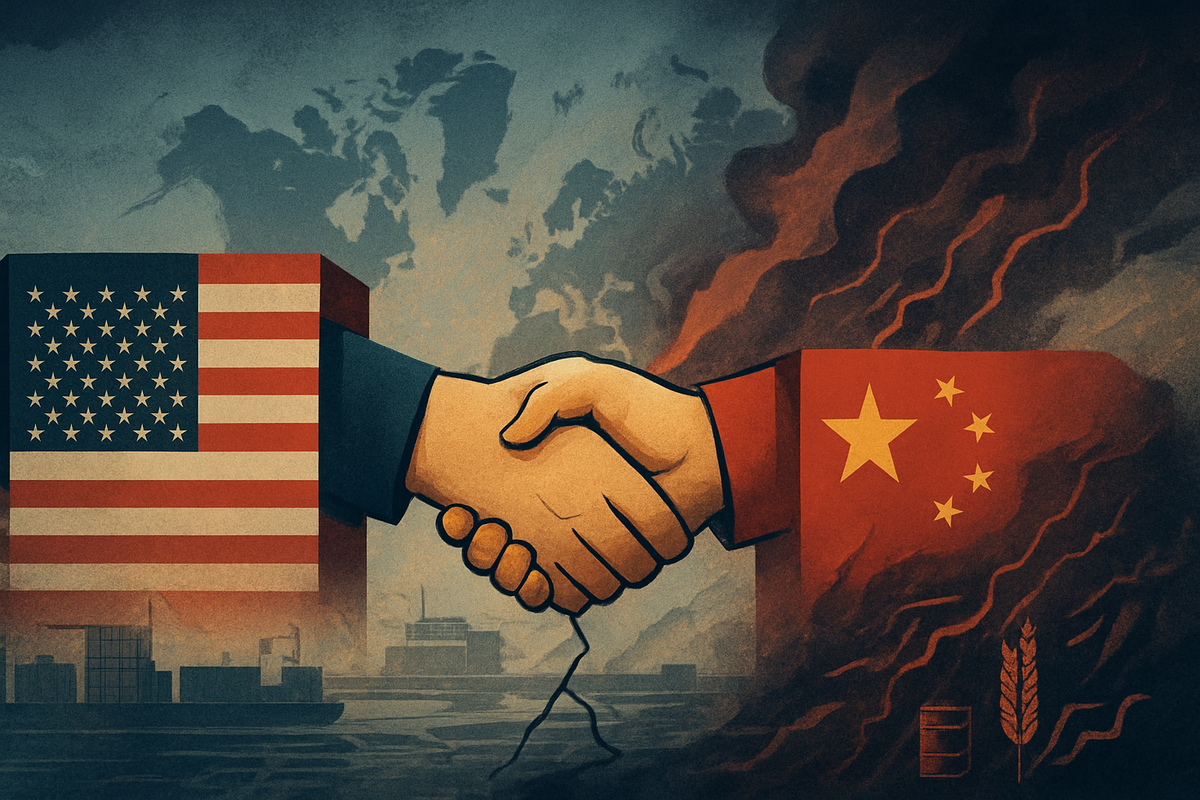
Hong Kong, November 4, 2025 – Global financial markets today present a complex picture, oscillating between cautious optimism fueled by a temporary U.S.-China trade truce and persistent anxieties stemming from ongoing geopolitical conflicts in Ukraine and between Israel and Hamas. While the recent de-escalation in trade tensions has provided a much-needed boost to Hong Kong's markets, the broader international landscape remains fraught with disruptions to cross-border trade, elevated commodity prices, and increased sovereign risk premiums worldwide.
The temporary accord between Washington and Beijing, announced just days ago, has offered a glimmer of hope for stability, particularly impacting Asian markets. However, the shadow of prolonged conflicts in Eastern Europe and the Middle East continues to loom large, ensuring that global supply chains and investment flows remain under considerable pressure. Investors are grappling with this dichotomy, seeking opportunities in the brief lulls of trade disputes while bracing for the economic fallout of entrenched geopolitical strife.
A Fragile Peace: Trade Truce and Enduring Conflicts Shape Market Sentiment
The current state of global markets on November 4, 2025, is primarily defined by two major forces: a temporary U.S.-China trade truce and the persistent economic disruptions caused by the wars in Ukraine and between Israel and Hamas. The U.S.-China agreement, reached after a high-level meeting between U.S. President Donald Trump and Chinese President Xi Jinping on October 31, 2025, represents a constructive, albeit temporary, step towards easing trade tensions. This one-year window for further negotiations aims to address simmering disputes without a formal, binding agreement, leaving analysts cautious about its long-term stability.
Key aspects of this truce include China's commitment to suspend new export controls on critical minerals such as rare earths, gallium, germanium, antimony, and graphite, reversing measures imposed earlier in 2025 and 2022. Beijing also agreed to suspend retaliatory tariffs on a wide range of U.S. agricultural products and pledged substantial purchases of U.S. soybeans, sorghum, and hardwood logs. Furthermore, China committed to curbing fentanyl flow to the U.S. and terminating antitrust investigations targeting U.S. semiconductor supply chain companies, ensuring the resumption of trade from Nexperia's facilities. In return, the U.S. will reduce tariffs on Chinese imports related to fentanyl flows, maintain the suspension of heightened reciprocal tariffs, and extend certain Section 301 tariff exclusions until November 2026. The U.S. also agreed to freeze plans for expanding its commerce department entity list, which restricts technology sales to certain Chinese firms.
The immediate impact on Hong Kong's financial markets was mixed but generally positive. On Monday, November 3, 2025, the Hang Seng Index (HKEX: HSI) closed 1% higher, buoyed by the suspension of China's rare earth export controls and the termination of investigations into U.S. chip firms. However, this optimism was tempered by a slight dip on November 4, 2025, with the Hang Seng Index falling 0.8%, reflecting lingering unease over the agreement's limited scope, particularly its failure to resolve restrictions on advanced technology like Nvidia (NASDAQ: NVDA) chips. Exporters in Hong Kong, however, expressed a "collective sigh of relief," as the one-year truce provides greater certainty for their 2026 business planning, despite the continued application of a 10% reciprocal tariff.
Meanwhile, the protracted conflict in Ukraine, ongoing since February 2022, continues to profoundly disrupt global trade, particularly in energy and agriculture. Sanctions against Russia and damaged Ukrainian infrastructure have hampered critical commodity exports, leading to persistent logistical challenges and shifts in global supply chains. Commodity prices, while having seen some adjustments since the initial surge in early 2022, remain sensitive to the conflict's progression. Similarly, the Israel-Hamas conflict, which escalated in October 2023, has contributed to global economic instability. While a ceasefire agreement around October 9-10, 2025, led to a "risk-premium release valve" in commodity markets, causing oil prices to fall sharply and easing concerns over key crude oil transport routes, the underlying tensions and potential for renewed escalation continue to cast a shadow over investment and trade flows, particularly in the Middle East and globally.
Corporate Fortunes: Navigating the Geopolitical Crosscurrents
The current global economic environment, characterized by a fragile U.S.-China trade truce juxtaposed with persistent geopolitical conflicts, is creating distinct winners and losers across various sectors and public companies. The temporary de-escalation in trade tensions offers a much-needed reprieve for some, while the ongoing wars and their ripple effects continue to pose significant challenges for others.
On the winning side, sectors with substantial exposure to U.S.-China trade stand to benefit from the recent truce. U.S. agricultural producers, particularly those involved in soybean and other crop exports, are poised for increased demand as China resumes purchases. Major agricultural commodity players like Archer-Daniels-Midland (NYSE: ADM) and Bunge Limited (NYSE: BG) could see improved pricing power and stronger earnings. Similarly, companies in footwear and apparel, such as Nike (NYSE: NKE), Foot Locker (NYSE: FL), Dick's Sporting Goods (NYSE: DKS), and Under Armour (NYSE: UAA), which source heavily from Asia, are likely to benefit from reduced tariffs and more stable supply chains. Retail giants like Walmart (NYSE: WMT), Target (NYSE: TGT), and Home Depot (NYSE: HD) could also experience relief from lower import costs, potentially boosting consumer spending. The technology and electronics sector, especially firms dependent on critical minerals like rare earths, will gain from eased export restrictions, benefiting companies such as Apple (NASDAQ: AAPL), Nvidia (NASDAQ: NVDA), Intel (NASDAQ: INTC), and Qualcomm (NASDAQ: QCOM) through improved cost predictability and reduced supply chain risks. China's domestic tech players like Alibaba (NYSE: BABA), Baidu (NASDAQ: BIDU), and Tencent (HKEX: 0700) may also see a sentiment rebound. Furthermore, the shipping and logistics industry, including operators like Maersk (CPH: MAERSK-B), FedEx (NYSE: FDX), and COSCO Shipping (HKEX: 1919), could see revived global trade volumes. Hong Kong-based exporters and manufacturers, particularly in electronics and textiles, are expected to experience a collective sigh of relief, allowing for renewed strategic planning and capital investment.
Conversely, a broad spectrum of companies and sectors are facing significant headwinds due to ongoing geopolitical conflicts, elevated commodity prices, and increased sovereign risk premiums. Industries heavily reliant on global supply chains, such as manufacturing and automotive, are particularly vulnerable to disruptions caused by the Ukraine and Israel-Hamas conflicts, leading to increased transit times and costs. Energy-intensive sectors will continue to grapple with price volatility and supply disruptions in oil and gas markets. Companies with direct operations or investments in conflict zones face risks of infrastructure damage and operational instability. Multinational companies dealing with sanctioned entities, like those impacted by restrictions related to the Russia-Ukraine conflict, face financial and reputational damage if they fail to comply with evolving regulations.
Elevated commodity prices directly squeeze profit margins for manufacturers, transportation companies, and consumer goods producers if they cannot pass these increases onto customers. For instance, higher fuel costs directly impact the profitability of airlines and shipping companies, while increased raw material costs affect construction and real estate. Furthermore, companies with high debt loads will face higher borrowing costs as sovereign risk premiums rise, increasing interest rates for corporate lending and affecting their financial stability. Financial institutions with exposure to sovereign debt of riskier nations could see increased default risk. Companies operating in emerging markets, especially those with significant foreign-currency debt, become more vulnerable to exchange rate fluctuations and increased debt servicing costs when sovereign risk premiums escalate, deterring foreign investment and impacting growth.
A New Global Order: Reshaping Supply Chains, Energy Security, and the March of Deglobalization
The confluence of U.S.-China trade dynamics and persistent geopolitical conflicts in Ukraine and the Middle East is not merely a series of isolated events but a powerful catalyst fundamentally reshaping broader industry trends. These intertwined factors are accelerating shifts in supply chain diversification, redefining energy security paradigms, and propelling the global economy further down the path of deglobalization, with significant ripple effects for competitors, partners, and the global regulatory landscape.
The U.S.-China trade conflict, characterized by tariffs, sanctions, and export restrictions, has been the primary driver behind a significant push for supply chain diversification. Multinational corporations are actively pursuing "China+1" strategies, relocating portions of their manufacturing to countries like Vietnam, India, and Mexico. This movement, encompassing "reshoring" and "nearshoring," aims to mitigate risks associated with geopolitical instability and over-reliance on a single production hub. Governments, including the U.S. with its CHIPS and Science Act, are actively supporting domestic production in strategic sectors. However, this diversification is complex; a phenomenon dubbed "superficial decoupling" sees China remain a crucial source of intermediate goods, with final assembly shifting elsewhere to circumvent tariffs. Moreover, China's increasing investment in "friendshore" nations suggests that Chinese-owned plants may retain an indirect role in U.S. supply chains, and some companies are even considering "reverse friendshoring" to serve the growing Asian market.
Energy security has emerged as another critical concern amidst geopolitical tensions. China, heavily reliant on energy imports, faces vulnerabilities that could be exacerbated by trade disputes. The competition extends to critical minerals, essential for clean energy technologies like solar, wind, batteries, and electric vehicles (EVs), where China holds a dominant position in production. U.S. trade policies, including tariffs and export controls on critical minerals such as rare earths, gallium, germanium, antimony, and graphite, are actively reshaping clean energy supply chains and driving investments in third countries to reduce dependency. The Ukraine conflict has further intensified this focus, highlighting the fragility of relying on politically unstable regions for vital resources.
These developments collectively underscore a broader trend of deglobalization, a "megatrend" accelerated by U.S.-China strategic competition, a resurgence of protectionist policies, the 2008 financial crisis, and the COVID-19 pandemic. This trend manifests in decelerating trade and investment flows and the shortening of global value chains. While a complete collapse of the global economy is unlikely, the trajectory points towards the emergence of partially closed trading blocs, organized either geographically or around shared strategic interests and political values. This shift prioritizes national security and resilience over pure economic efficiency, marking a defining characteristic of the evolving global economic order.
The ripple effects are profound. Countries like Vietnam, India, and Mexico are emerging as beneficiaries of trade diversion, attracting increased manufacturing investment as companies seek alternatives to China. However, a temporary easing of U.S.-China tensions could see some of these advantages diminish. U.S. allies in Europe and Japan face a delicate balancing act, navigating their economic ties with both giants while potentially being pressured to align their supply chains away from China under "friendshoring" policies. The regulatory and policy landscape is becoming increasingly complex and bifurcated, with the U.S. employing tariffs, sanctions, and export controls, and China responding with its own economic statecraft instruments like the Anti-Foreign Sanctions Law and an Unreliable Entity List. This forces multinational companies to navigate often incompatible compliance requirements, potentially compelling them to choose between access to U.S. or Chinese markets.
Historically, periods of heightened trade tension and geopolitical rivalry offer stark lessons. The Smoot-Hawley Tariff Act of 1930, which led to retaliatory tariffs and a collapse in global trade, serves as a warning against protectionism. Early trade wars in the 17th century between Britain and the Dutch Republic illustrate the long history of economic conflict driven by national interests. The 1973 Arab Oil Embargo demonstrated how critical resources could be weaponized. While the U.S.-Japan trade wars of the 1980s involved disputes over specific sectors, the current U.S.-China conflict is far broader, encompassing industrial policies, cybersecurity, human rights, and technological leadership. The present situation bears similarities to the Cold War era, with ideological conflicts and the formation of distinct economic blocs, though the current trend leans towards "partially closed trading blocs" rather than complete deglobalization.
The Road Ahead: Navigating Uncertainty and Strategic Imperatives
The path forward for global markets, U.S.-China trade relations, and the resolution of ongoing geopolitical conflicts remains fraught with uncertainty, demanding strategic pivots and agile adaptations from businesses and policymakers alike. While a temporary truce offers a brief respite, the underlying structural challenges and deeply entrenched geopolitical rivalries suggest a future of continued flux.
In the short term, U.S.-China trade relations are expected to maintain a tactical de-escalation, building on the "basic consensus" reached in late 2025. This includes some tariff reductions and a pause on specific export restrictions, aiming to stabilize trade flows and inject a degree of optimism into global financial markets. However, the long-term outlook points to a "recurring cycle of tension-truce-tension," as fundamental issues like China's industrial policy and non-market practices remain largely unresolved. Both nations are intensely focused on "selective decoupling," aiming to reduce dependence on each other for key supply chains, which could lead to dwindling bilateral trading volumes and financial flows over time. For the Ukraine conflict, a high-intensity war of attrition is expected to continue in the short-to-medium term, with little prospect for a lasting diplomatic resolution between the Putin and Zelensky administrations. Military escalation remains a strong possibility. The Israel-Hamas conflict is also very likely to continue into 2025, with deep-seated grievances impeding significant compromise and an ongoing risk of regional spillover, particularly if major regional powers like Iran become directly involved.
In this volatile environment, businesses must adopt proactive and agile strategies. Key strategic pivots include deepening geopolitical understanding and integrating these considerations into routine operations. Supply chain diversification and localization, through reshoring or nearshoring production, are critical to mitigate disruptions from trade restrictions and conflicts, albeit potentially at increased capital costs. Companies must also explicitly define their geopolitical risk appetite, balancing the trade-offs of operating in high-tension regions versus relocating. Continuous assessment and reallocation of capital to higher-growth, lower-risk segments, alongside divestment from underperforming, high-risk areas, will be crucial. Technological innovation, particularly leveraging AI, can help optimize resource use and maintain competitiveness amidst inflationary pressures. Developing market-specific strategies and regionalized approaches, focusing on less geopolitically contested regions, is also vital as globalization "rewires." Finally, robust crisis response planning and scenario-planning exercises are essential for rapid adaptation to operational and market disruptions.
Emerging markets present a dual landscape of opportunities and challenges. On the opportunity side, many offer high growth potential, expanding middle classes, digital transformation, and significant investments in sustainable development and infrastructure. They also provide avenues for supply chain diversification and access to natural resources. Regions such as Latin America, Sub-Saharan Africa, and Southeast Asia may offer growth relatively insulated from the primary geopolitical rivalries. However, these markets also face significant challenges, including political instability, economic volatility (e.g., commodity price fluctuations, currency depreciation), infrastructure gaps, and complex regulatory environments. Geopolitical tensions exacerbate foreign investment risks, necessitating careful adaptation or even exit from volatile markets.
The future for global markets, commodity prices, and investment flows will likely unfold across several scenarios. The most probable "base case" suggests subdued growth with persistent uncertainty, where geopolitical tensions remain significant overhangs, leading to elevated commodity prices and "higher-for-longer" interest rates. A "downside scenario" could see increased fragmentation, intensified trade wars, or a sharp financial market correction, with escalating conflicts causing commodity prices to soar and potentially triggering a global recession. In this scenario, investment flows would heavily shift towards safe-haven assets. An "upside scenario," though less likely given current trends, could involve an innovation-led recovery fueled by AI and renewed multilateral cooperation, leading to genuine de-escalation in conflicts and a more stable U.S.-China trade relationship, fostering robust global economic growth and revitalizing emerging markets. Regardless of the scenario, geopolitical events will continue to spark sudden and unpredictable market movements, emphasizing the importance of defensive equities and safe-haven assets during crises.
Comprehensive Wrap-Up: Navigating a Fragmented Future
The global financial landscape as of November 4, 2025, is defined by a delicate balance between a temporary U.S.-China trade truce and the persistent, disruptive forces of ongoing geopolitical conflicts. This dual reality shapes market sentiment, corporate strategy, and the very structure of the global economy. While the recent de-escalation in trade tensions has offered a much-needed breath of fresh air for Hong Kong markets and specific sectors, the entrenched nature of conflicts in Ukraine and between Israel and Hamas ensures that uncertainty, elevated commodity prices, and increased sovereign risk premiums will remain defining features of the investment environment.
The key takeaway from these intertwined events is the accelerating trend towards a more fragmented and regionalized global economy. The U.S.-China trade friction is fundamentally reshaping supply chains, driving companies to diversify away from over-reliance on single hubs, even if this leads to "superficial decoupling" or "reverse friendshoring." Energy security has become a paramount concern, intensifying competition for critical minerals and driving investments in resilient, localized supply chains for clean energy technologies. This strategic competition, coupled with a global resurgence of protectionist policies, is propelling a broader deglobalization trend, leading towards the formation of partially closed trading blocs where national security and resilience often outweigh pure economic efficiency.
Moving forward, investors should watch for the durability of the U.S.-China trade truce. Any signs of renewed escalation or a failure to address underlying structural issues could quickly erode market confidence. The trajectory of the conflicts in Ukraine and the Middle East will continue to be critical, particularly their potential to disrupt energy and food supplies, which would inevitably send commodity prices soaring and exacerbate global inflationary pressures. Businesses must prioritize agility, robust geopolitical understanding, and strategic supply chain diversification. This involves defining risk appetite, rebalancing investment portfolios, and leveraging technological innovation to adapt to market shifts and optimize resource use.
In the coming months, the global market will continue to be a battleground between cautious optimism and pervasive risk. While opportunities may emerge in less geopolitically contested emerging markets or through innovative technological solutions, the overarching theme will be resilience. Companies and investors that can anticipate and adapt to rapid shifts in global dynamics, focusing on diversification, regionalized strategies, and a keen awareness of geopolitical currents, will be best positioned to navigate this increasingly complex and fragmented world.
This content is intended for informational purposes only and is not financial advice





